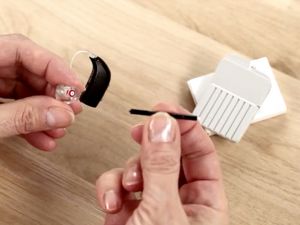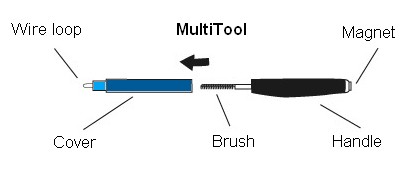Hearing aids are a significant investment, so it’s good practice to learn how to clean and maintain them at home. Unlike most electronics, hearing aids have to operate in conditions that are far from ideal: the inside of your ear canals where they are subjected to earwax and moisture. Regular cleaning you can do yourself combined with routine maintenance provided by your hearing care professional will give you years of reliable better hearing. Before you get started, it may be helpful to review the various parts of a hearing aid.
Table of Contents
Care tips for hearing aids

them working reliably. (Image courtesy
Oticon)
- Get the proper tools: A wax pick and brush are indispensable tools for at-home cleaning. Earwax can accumulate in the opening at the end of a hearing aid where the sound comes out causing muffled sound or feedback (whistling). Left long enough, it can damage the receiver. Use the pick and brush to gently clear wax away.
- Establish good habits: Always wash your hands well before cleaning your hearing aids. Leave hearing aids out during your hygiene routine. Shower and wash your face and hair without your hearing aids in so water and soap can’t damage them. Put your aids in after you apply hair products like sprays or gels.
- Clean your device at the end of the day: Cleaning your hearing aids before bedtime gives them several hours to air out before you will put them in again. Avoid wipes with chemicals or alcohol when cleaning hearing aids as they could damage the devices.
- Avoid extreme heat or cold: If the temperature is below freezing and you take your hearing aids out of your ears to shovel the driveway, leave them inside the house instead of stashing them in your coat pocket. Likewise, if you take your hearing aids out to jump in the pool on the hottest day of the summer, take them inside the house instead of leaving them on a poolside table.
How to clean ITE (in the ear) hearing aids
When cleaning an ITE model, follow these steps:
- Focus your cleaning on the openings in the device including the microphone ports using a soft-bristle toothbrush or a brush provided by your hearing healthcare professional to clear away built up wax. Hold the device with the opening you are cleaning facing downward so any loose particles will fall out of the hearing aid instead of staying lodged inside.
- Next, use a wax pick or hook to clear anything out of the holes that didn’t come out with the brush.
- Finish by wiping the entire device with a clean, dry cloth or tissue. This will remove debris from the case of the hearing aid.
How to clean BTE (behind the ear) hearing aids
To clean a BTE hearing aid and earmold, follow these steps:
- Examine the device for debris and remove it with a soft brush or a dry cloth.
- Remove the earmold from the hook to clean it. Some earmolds, especially those made from soft materials, can become discolored and stain over time. Wiping them clean daily and soaking them in warm, soapy water once each week will help. Allow the molds to dry completely overnight before use, and do not use alcohol or other chemicals on them. Your earmolds may develop a slight odor over time, but a strong odor could indicate you have an ear infection, so consult your hearing healthcare professional if you notice it.
- Use a bulb blower to force water out of the tubing and then allow it to dry completely overnight.

Additional considerations
For all types of hearing aids, do the following at night:
- Remove the batteries and keep the battery compartment open to dry overnight. If they’re rechargeable, dock them according to the manufacturer’s specifications.
- Brush the battery compartment with the cleaning brush.
It may be worthwhile to use a hearing aid dehumidifier, especially if you live in a humid climate, spend considerable time outdoors or perspire heavily. There are two types of hearing aid dehumidifiers. One type is a simple plastic jar with a desiccant that draws out moisture overnight. The other type is called a dry & store unit that uses ultraviolet light and air to dry and sanitize hearing aids. Both accessories are probably available through your hearing healthcare professional or online. See other accessories you may want to invest in.
Proper cleaning and maintenance will help you get years of trouble-free wear with your hearing aids.
Hearing aid cleaning tools
While these tools can be purchased online or at most drug stores, consult first with your hearing healthcare provider to find out which tools are best for your particular hearing aids.
These common tools help keep hearing aids in pristine condition:
- Hearing aid cleaning brush: The soft brush tip end cleans the body, faceplate or sound port of a hearing device. Some brushes have a magnetic battery removal tool to ease daily cleaning of aids.
- Wax pick or wire loop: This tool is designed to help remove wax and other debris safely from hearing aid nooks and holes.
- Multi-tool: These all-in-one tools are versatile because they contain both a brush and a wax loop for thorough cleaning.
When to see a professional
Hearing aids should be professionally cleaned regularly as recommended by your hearing care provider. They have vacuums with specialized attachments that gently suck wax from hard to reach areas, and they know how to safely clean vents, microphone screens, windscreens and receivers.
If you are not sure how to properly clean your hearing aids or if you feel your devices need special attention, ask your hearing care professional for help. If you need help finding an audiologist or hearing care specialist near you, our directory of consumer-reviewed hearing clinics is a good place to start.

